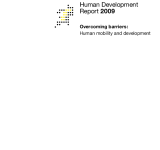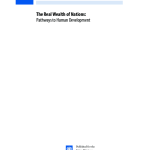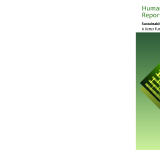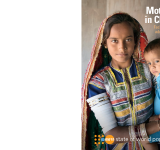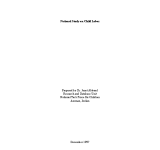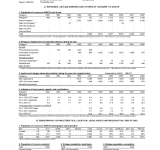Migration;; both within and beyond borders;; has become an increasingly prominent theme in domestic and international debates;; and is the topic of the 2009 Human Development Report (HDR09). The starting point is that the global distribution of capabilities is extraordinarily unequal;; and that this is a major driver for movement of people. Migration can expand their choices —in terms of incomes;; accessing services and participation;; for example— but the opportunities open to people vary from those who are best endowed to those with limited skills and assets. These underlying inequalities;; which can be compounded by policy distortions;; is a theme of the report. The report investigates migration in the context of demographic changes and trends in both growth and inequality. It also presents more detailed and nuanced individual;; family and village experiences;; and explores less visible movements typically pursued by disadvantaged groups such as short term and seasonal migration.
population
The 2010 Report continues the tradition of pushing the frontiers of development thinking. For the first time since 1990;; the Report looks back rigorously at the past several decades and identifies often surprising trends and patterns with important lessons for the future. These varied pathways to human development show that there is no single formula for sustainable progress—and that impressive long-term gains can and have been achieved even without consistent economic growth. Looking beyond 2010;; this Report surveys critical aspects of human development;; from political freedoms and empowerment to sustainability and human security;; and outlines a broader agenda for research and policies to respond to these challenges.
The 2011 Human Development Report argues that the urgent global challenges of sustainability and equity must be addressed together – and identifies policies on the national and global level that could spur mutually reinforcing progress towards these interlinked goals. Past Reports have shown that living standards in most countries have been rising - and converging - for several decades now. Yet the 2011 Report projects a disturbing reversal of those trends if environmental deterioration and social inequalities continue to intensify;; with the least developed countries diverging downwards from global patterns of progress by 2050. The Report shows further how the world's most disadvantaged people suffer the most from environmental degradation;; including in their immediate personal environment;; and disproportionately lack political power;; making it all the harder for the world community to reach agreement on needed global policy changes. The Report also outlines great potential for positive synergies in the quest for greater equality and sustainability;; especially at the national level. The Report further emphasizes the human right to a healthy environment;; the importance of integrating social equity into environmental policies;; and the critical importance of public participation and official accountability. The 2011 Report concludes with a call for bold new approaches to global development financing and environmental controls;; arguing that these measures are both essential and feasible.
The 21st century is witnessing a profound shift in global dynamics;; driven by the fast-rising new powers of the developing world. China has overtaken Japan as the world's second biggest economy;; lifting hundreds of millions of people out of poverty in the process. India is reshaping its future with new entrepreneurial creativity and social policy innovation. Brazil is raising its living standards by expanding international relationships and antipoverty programmes that are emulated worldwide. But the “Rise of the South” is a much larger phenomenon. Indonesia;; Mexico;; South Africa;; Thailand;; Turkey and other developing countries are becoming leading actors on the world stage. The 2013 Human Development Report identifies more than 40 developing countries that have done better than expected in human development in recent decades;; with their progress accelerating markedly over the past 10 years.
يبرز تقرير حالة سكان العالم 2013;; الصادر عن صندوق الأمم المتحدة للسكان;; التحديات الرئيسية المتعلقة بحمل المراهقات وآثاره الخطيرة على تعليم الفتاة;; وصحتها;; وفرصها في العمل في الأجل الطويل. ويبين التقرير أيضا ما يمكن القيام به من أجل الحد من هذا الاتجاه وحماية حقوق الإنسان الخاصة بالفتيات ورفاهتهن.
This report analyzes the nature of child labor in Jordan. Child labor is defined as “the active participation of any child less than 16 years of age in any economic activity;; regardless of the type of work;; the employer;; the nature of the job;; or the activity.” This report examines the magnitude of child labor in Jordan based on the existing information and the collection of additional field data (both qualitative and quantitative) on the causes;; conditions;; and consequences of child labor. This report also aims to identify sub-populations of children most at risk to child labor;; investigate inadequacies in Jordanian laws and legislation with regards to child labor;; and examine vocational training programs and existing non-formal education programs for school drop-outs in relation to child labor. With regards to methodology;; information on child labor in Jordan was obtained through both primary and secondary sources;; including previous studies;; interviews;; and a field survey. After careful analysis;; this report makes a number of recommendations which aim to combat illegal of harmful child labor in Jordan.
The following report details statistical information regarding refugees;; asylum-seekers;; and others in Jordan accumulated by the United Nations High Commissioner for Refugees for the year 2002.
يتضمن هذا التقرير النتائج الرئيسية للجولات الأربع للمسح التي تم تنفيذها خلال أشهر شباط;; أيار;; آب;; وتشرين الثاني عام 2007;; بعد أن تم دمج البيانات مع بعضها البعض بتعطي مؤشرات سنوية على مستوى عام 2007. حيث غطت الجولات المسح الأربع عينة من الأسر بلغ حجمها 53 ألف أسرة بصورة تضمن التمثيل على مستوى المملكة والأقاليم والحضر والريف;; والمحافظات. واستندت هذه العينة على الاطار الذي وفرته نتائج التعداد العام للسكان والمساكن لعام 2004. ويشمل التقرير على اﻟﺨﺼﺎﺋﺺ الديموغرافية واﻻﺟﺘﻤﺎﻋﻴﺔ واﻻﻗﺘﺼﺎدﻳﺔ ﻟﻘﻮة العمل;; بالاضافة إلى التعرف على معدلات المشاركة الإقتصادية ومتسوياتها في سوق العمل الأردني;; وكذلك قياس معدلات البطالة وأسبابها حسب المحافظات وخصائص مختلفة كالمستوى التعليمي والحالة الزواجية والعمر.
